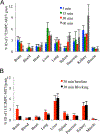Radiosynthesis and in Vivo Evaluation of [11C]MPC-6827, the First Brain Penetrant Microtubule PET Ligand
- PMID: 29457976
- PMCID: PMC6637745
- DOI: 10.1021/acs.jmedchem.8b00028
Radiosynthesis and in Vivo Evaluation of [11C]MPC-6827, the First Brain Penetrant Microtubule PET Ligand
Abstract
Abnormalities of microtubules (MTs) are implicated in the pathogenesis of many CNS diseases. Despite the potential of an MT imaging agents, no PET ligand is currently available for in vivo imaging of MTs in the brain. We radiolabeled [11C]MPC-6827, a high affinity MTA, and demonstrated its specific binding in rat and mice brain using PET imaging. Our experiments show that [11C]MPC-6827 has specific binding to MT in brain, and it is the first MT-binding PET ligand.
Figures




Similar articles
-
In vivo comparison of N-11CH3 vs O-11CH3 radiolabeled microtubule targeted PET ligands.Bioorg Med Chem Lett. 2020 Jan 15;30(2):126785. doi: 10.1016/j.bmcl.2019.126785. Epub 2019 Nov 9. Bioorg Med Chem Lett. 2020. PMID: 31753695 Free PMC article.
-
Preliminary mechanistic insights of a brain-penetrant microtubule imaging PET ligand in a tau-knockout mouse model.EJNMMI Res. 2022 Jul 26;12(1):41. doi: 10.1186/s13550-022-00912-z. EJNMMI Res. 2022. PMID: 35881263 Free PMC article.
-
Preclinical evaluation of a microtubule PET ligand [11C]MPC-6827 in tau and amyotrophic lateral sclerosis animal models.Pharmacol Rep. 2022 Jun;74(3):539-544. doi: 10.1007/s43440-022-00359-y. Epub 2022 Mar 14. Pharmacol Rep. 2022. PMID: 35286710
-
Efficiency gains in tracer identification for nuclear imaging: can in vivo LC-MS/MS evaluation of small molecules screen for successful PET tracers?ACS Chem Neurosci. 2014 Dec 17;5(12):1154-63. doi: 10.1021/cn500073j. Epub 2014 Oct 13. ACS Chem Neurosci. 2014. PMID: 25247893 Review.
-
Radiolabeled ligands for imaging the muscarinic-cholinergic receptors of the heart and brain.Anticancer Res. 1997 May-Jun;17(3B):1559-72. Anticancer Res. 1997. PMID: 9179195 Review.
Cited by
-
Initial biological evaluations of 18F-KS1, a novel ascorbate derivative to image oxidative stress in cancer.EJNMMI Res. 2019 May 17;9(1):43. doi: 10.1186/s13550-019-0513-x. EJNMMI Res. 2019. PMID: 31101996 Free PMC article.
-
Glioblastoma: Current Status, Emerging Targets, and Recent Advances.J Med Chem. 2022 Jul 14;65(13):8596-8685. doi: 10.1021/acs.jmedchem.1c01946. Epub 2022 Jul 5. J Med Chem. 2022. PMID: 35786935 Free PMC article. Review.
-
Binding Parameters of [11C]MPC-6827, a Microtubule-Imaging PET Radiopharmaceutical in Rodents.Pharmaceuticals (Basel). 2023 Mar 27;16(4):495. doi: 10.3390/ph16040495. Pharmaceuticals (Basel). 2023. PMID: 37111252 Free PMC article.
-
[18F]KS1, a novel ascorbate-based ligand images ROS in tumor models of rodents and nonhuman primates.Biomed Pharmacother. 2022 Dec;156:113937. doi: 10.1016/j.biopha.2022.113937. Epub 2022 Oct 29. Biomed Pharmacother. 2022. PMID: 36411624 Free PMC article.
-
Radiosynthesis and evaluation of [11C]CMP, a high affinity GSK3 ligand.Bioorg Med Chem Lett. 2019 Mar 15;29(6):778-781. doi: 10.1016/j.bmcl.2019.01.033. Epub 2019 Jan 25. Bioorg Med Chem Lett. 2019. PMID: 30709652 Free PMC article.
References
Publication types
MeSH terms
Substances
Grants and funding
LinkOut - more resources
Full Text Sources
Other Literature Sources

